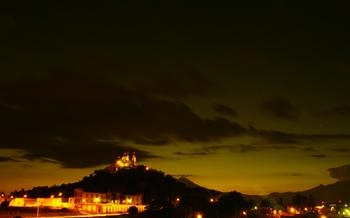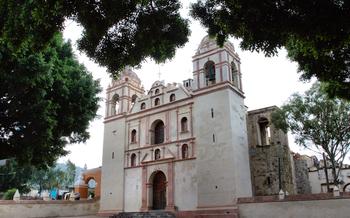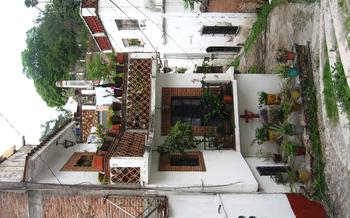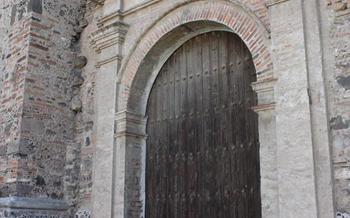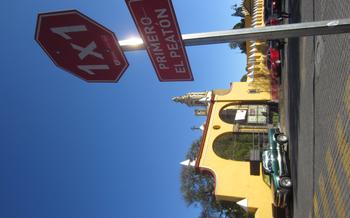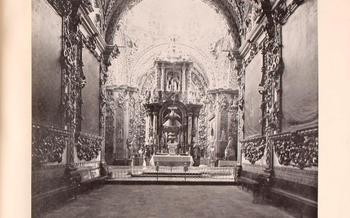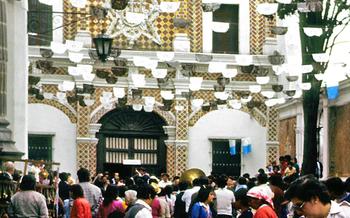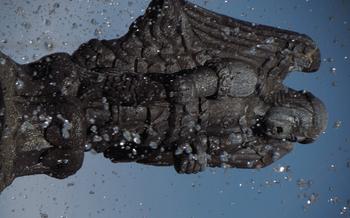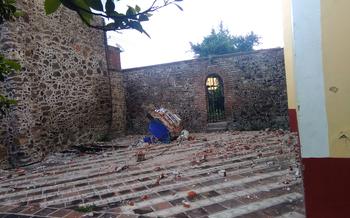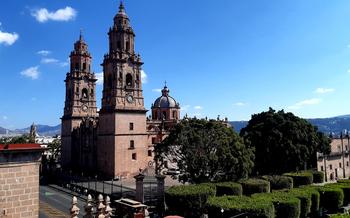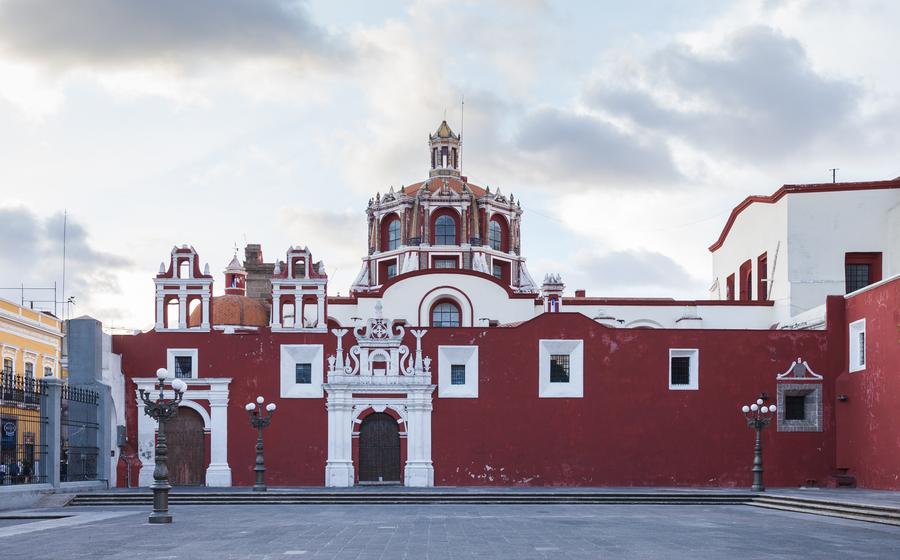
Iglesia de Santo Domingo
- Iglesia de Santo Domingo: A Baroque Masterpiece in Puebla
- Exquisite Façade: A Symphony of Detail
- The Majestic Dome: A Symbol of Divine Grandeur
- The Captivating Towers: Guardians of the City
- The Rose Window: A Portal to Divine Light
- The Altarpiece: A Symphony of Gold and Glory
- The Chapel of the Rosary: A Baroque Jewel
- The Museum of the Church: A Journey Through History
- The Sala Capitular: A Hidden Gem of Art and History
- The Courtyard: A Peaceful Oasis in the Heart of the City
- The Sacristy: A Treasure Trove of Religious Art
- The Organ: A Musical Masterpiece with a Divine Sound
- The Convent of Santo Domingo: A Glimpse into Monastic Life
- The Cultural Center: A Hub of Arts and Education
- Insider Tip: Discover the Hidden Rooftop Terrace
Iglesia de Santo Domingo: A Baroque Masterpiece in Puebla
In the heart of Puebla, Mexico, stands the magnificent Iglesia de Santo Domingo, a testament to the city's rich colonial heritage and a masterpiece of Baroque architecture. Its stunning facade, intricate domes, and towering spires create an awe-inspiring spectacle that leaves visitors breathless. As you step inside, the opulent interior adorned with gold leaf, intricate carvings, and vibrant frescoes transports you back in time, offering a glimpse into the grandeur and devotion of the past. Prepare to be captivated as you explore this architectural marvel, a UNESCO World Heritage Site that embodies the artistic and spiritual essence of Puebla.
Exquisite Façade: A Symphony of Detail
The facade of the Iglesia de Santo Domingo is a captivating display of Baroque artistry, showcasing intricate carvings, sculptures, and reliefs that tell a visual story of faith and devotion. The central portal, flanked by imposing columns, features a series of niches housing life-size sculptures of saints and biblical figures. The tympanum above the portal is adorned with a relief depicting the Last Judgment, with intricate details portraying the rewards of heaven and the punishments of hell.
The facade's elaborate ornamentation extends to the upper levels, where a series of balconies and windows are framed by decorative moldings and carvings. The second level features a row of eight niches, each containing a statue of a Dominican saint, while the third level showcases a delicate balustrade with intricate stonework. The overall effect is one of awe-inspiring grandeur, with every element contributing to the facade's rich visual narrative.
The symbolism embedded in the facade's imagery is equally captivating. The sculptures and reliefs convey messages of faith, hope, and redemption, reminding visitors of the church's spiritual significance. The prominent depictions of Dominican saints highlight the order's role in spreading Catholicism throughout the region. The Last Judgment scene serves as a powerful reminder of the consequences of one's actions, encouraging viewers to lead virtuous lives.
The facade of the Iglesia de Santo Domingo is not merely a decorative element; it is a testament to the skill and artistry of the Baroque era. The attention to detail, the intricate carvings, and the symbolic imagery combine to create a masterpiece that leaves visitors in awe and wonder.
The Majestic Dome: A Symbol of Divine Grandeur
The dome of the Iglesia de Santo Domingo is an architectural marvel that dominates the Puebla skyline, symbolizing the church's grandeur and religious significance. Rising high above the city, the dome is a testament to the skill and ingenuity of the builders who created it. Its vast size and intricate ornamentation make it a breathtaking sight, leaving visitors in awe of its beauty and majesty.
The dome's design is a masterpiece of architectural engineering, featuring a graceful curvature that creates a sense of lightness and elegance. The exterior is adorned with intricate patterns, sculptures, and reliefs that depict religious scenes and figures, adding to its visual appeal. The interior of the dome is equally impressive, with elaborate frescoes and paintings that cover the entire surface. These murals depict biblical stories and celestial beings, creating a celestial atmosphere that inspires a sense of devotion and wonder.
The dome of the Iglesia de Santo Domingo is not just an architectural masterpiece but also a powerful symbol of divine presence. In Christian architecture, the dome represents heaven and the dwelling place of God. Its towering height and grandeur convey the idea of reaching towards the heavens, connecting the earthly realm with the spiritual realm. The dome's intricate ornamentation and celestial imagery reinforce this symbolism, creating a sacred space that invites contemplation and spiritual connection.
The Captivating Towers: Guardians of the City
Soaring high above the city skyline, the twin towers of the Iglesia de Santo Domingo stand as majestic symbols of the church's power and authority. Their architectural style, characterized by intricate carvings and decorative elements, blends seamlessly with the rest of the church's Baroque facade. Originally serving as watchtowers, these towers provided a strategic vantage point for the city's defense. In addition to their practical function, the towers hold symbolic significance, representing strength, resilience, and the church's unwavering presence in the community.
Strolling through the bustling streets of Puebla, I couldn't help but be drawn to the mesmerizing sight of these towers. Their sheer height and grandeur commanded attention, inviting me to explore further. As I approached the church, I marveled at the intricate details adorning the towers. Each stone seemed to tell a story, whispering secrets of the past.
I couldn't resist the urge to climb the narrow staircase that led to the top of one of the towers. With each step, I felt a sense of anticipation building within me. As I emerged onto the rooftop terrace, a breathtaking panorama unfolded before my eyes. The city stretched out in all its glory, a tapestry of colorful buildings and vibrant streets. Mountains stood sentinel in the distance, their peaks capped with a dusting of snow.
Standing atop the tower, I felt a profound connection to the history and culture of Puebla. The city's rich heritage seemed to emanate from every corner and alleyway. I could almost sense the footsteps of the countless pilgrims and worshippers who had ascended these same steps over the centuries, seeking solace, guidance, and inspiration within the walls of the Iglesia de Santo Domingo.
The towers of the church are not just architectural wonders; they are symbols of faith, resilience, and the enduring spirit of the people of Puebla. They invite visitors to embark on a journey through time, to discover the stories and legends that have shaped this vibrant and captivating city.
The Rose Window: A Portal to Divine Light
The rose window of the Iglesia de Santo Domingo is a breathtaking masterpiece that captivates the eye with its intricate design and radiant colors. The window is composed of a central medallion surrounded by concentric circles of tracery, each adorned with delicate carvings and stained glass panels. The vibrant hues of blue, red, green, and yellow dance across the surface, creating a kaleidoscope of light that illuminates the interior of the church.
The rose window holds deep symbolic meaning, representing the Virgin Mary and the celestial realm. The central medallion depicts the Virgin Mary, surrounded by a halo of light and flanked by angels. The outer circles feature scenes from the life of Christ, as well as symbols of the four evangelists and the twelve apostles. This elaborate imagery serves as a visual reminder of the church's dedication to the Virgin Mary and the teachings of Christianity.
As sunlight streams through the stained glass, the rose window casts a warm glow on the interior of the church, creating a mystical and awe-inspiring atmosphere. The play of light and color transforms the space, inviting contemplation and a sense of connection with the divine.
Standing beneath the rose window, I felt a profound sense of tranquility and wonder. The intricate details and vibrant colors seemed to come alive, drawing me into a realm of spiritual contemplation. It was a moment of pure joy and inspiration, reminding me of the beauty and power of art to uplift the soul.
The Altarpiece: A Symphony of Gold and Glory
The altarpiece of the Iglesia de Santo Domingo is a masterpiece of Baroque art, showcasing the exceptional craftsmanship and artistry of the era. Its intricate carvings, sculptures, and gold leaf adornments create a symphony of gold and glory, capturing the eye and inspiring awe. The altarpiece depicts scenes from the life of Christ, saints, and biblical figures, each rendered with meticulous detail and emotional depth. The symbolism and allegory embedded in the imagery convey spiritual messages and lessons, inviting viewers to contemplate the deeper meanings behind the artwork. Standing before the altarpiece, one cannot help but feel a sense of wonder and reverence for the sacred artwork, a testament to the enduring power of faith and artistic expression.
The Chapel of the Rosary: A Baroque Jewel
Nestled within the confines of the Iglesia de Santo Domingo, the Chapel of the Rosary stands as a testament to the exquisite artistry and devotion that characterized the Baroque era. Its unique design, lavish decorations, and profound religious significance make it a must-see attraction for any visitor to Puebla.
The chapel's architectural features are a testament to the skill and creativity of its builders. The intricate tilework that adorns its walls and ceiling creates a visually stunning effect, while the frescoes and sculptures that populate its interior bring to life scenes from the life of Christ, the Virgin Mary, and other biblical figures.
Beyond its aesthetic beauty, the Chapel of the Rosary holds deep religious significance. Dedicated to the Virgin of the Rosary, the chapel serves as a place of worship and devotion for countless pilgrims and worshippers. The elaborate altar, adorned with gold leaf and intricate carvings, is a focal point of the chapel, inviting visitors to contemplate the mysteries of the Rosary and seek divine guidance.
My own experience visiting the Chapel of the Rosary was one of awe and inspiration. As I stepped inside, I was immediately struck by the sheer opulence and grandeur of the space. The intricate details of the tilework, the vibrant colors of the frescoes, and the serene atmosphere created by the flickering candles all combined to create a sense of profound spirituality. I found myself drawn to the altar, where I spent several moments in quiet contemplation, reflecting on the significance of the Rosary and the countless prayers that had been offered within these walls.
The Chapel of the Rosary is a true hidden gem, a place where art, history, and spirituality intertwine to create an unforgettable experience. Whether you are a devout Catholic, an art enthusiast, or simply a traveler seeking a moment of tranquility, the Chapel of the Rosary is a must-visit destination in Puebla.
The Museum of the Church: A Journey Through History
Step into the Museum of the Church, a treasure trove of historical artifacts, documents, and religious objects that narrate the rich history of the Iglesia de Santo Domingo. Immerse yourself in the past as you explore the museum's collection, gaining insights into the church's significance and its role in shaping Puebla's cultural heritage.
Interactive exhibits and displays bring the museum's collection to life, engaging visitors and providing a deeper understanding of the church's history and cultural impact. Guided tours are available, offering historical context and anecdotes that enhance the museum experience, making it an unforgettable journey through time.
My exploration of the museum was a journey of discovery, uncovering hidden stories and gaining a newfound appreciation for the church's rich heritage. Through the museum's collection and interactive displays, I felt a deeper connection to the history and significance of this magnificent edifice.
The Sala Capitular: A Hidden Gem of Art and History
Tucked away within the Iglesia de Santo Domingo is a hidden gem known as the Sala Capitular. This remarkable room served as a meeting place for the church's governing body and was also used to store important documents and artifacts. Its architectural features are simply breathtaking, with a vaulted ceiling adorned with intricate carvings and ornate decorations. The Sala Capitular houses a collection of paintings, sculptures, and other artworks representing various artistic styles and periods. It's a place where history and art intertwine, creating an atmosphere of reverence and wonder.
As I stepped into the Sala Capitular, I felt a sense of awe and discovery. The room's grandeur and the exquisite artworks transported me back in time. I imagined the solemn meetings that took place here, the decisions that shaped the church's history, and the secrets that were whispered within these walls. Each piece of art seemed to tell a story, inviting me to delve deeper into the rich tapestry of the church's heritage.
The Courtyard: A Peaceful Oasis in the Heart of the City
Nestled within the bustling city streets, the courtyard of the Iglesia de Santo Domingo offers a tranquil oasis, inviting visitors to escape the urban chaos and find a moment of serenity. Surrounded by elegant arcades, the courtyard is adorned with a central fountain, its gentle murmur creating a soothing ambiance. Lush vegetation, including vibrant flowers and towering trees, adds a touch of natural beauty, transforming the space into a verdant sanctuary.
Step into the courtyard, and you'll be greeted by a palpable sense of peace and tranquility. The hustle and bustle of the city seem to fade away as you immerse yourself in the courtyard's serene atmosphere. Take a moment to sit on one of the benches, enjoy the shade of the trees, and let the sound of the fountain wash away your worries.
In the courtyard, history and nature intertwine, creating a harmonious blend that transports visitors to a bygone era. Imagine friars strolling through the arcades, deep in contemplation, or gathering around the fountain to share stories and laughter. The courtyard served as a gathering place for religious ceremonies, processions, and community events, its peaceful ambiance providing a sacred space for spiritual connection and celebration.
Whether you're seeking a moment of respite from sightseeing or simply searching for a tranquil spot to reflect and rejuvenate, the courtyard of the Iglesia de Santo Domingo awaits. Let the serene atmosphere envelop you as you lose yourself in the beauty and tranquility of this hidden gem.
The Sacristy: A Treasure Trove of Religious Art
The sacristy of the Iglesia de Santo Domingo is a hidden gem, a treasure trove of religious art and artifacts that offer a glimpse into the church's rich history and devotion. Step inside this sacred space, and you'll be surrounded by an awe-inspiring collection of paintings, sculptures, and goldsmithing, each piece a testament to the artistic and cultural heritage of Puebla.
The sacristy served as a place where sacred objects and vestments were stored and prepared for religious ceremonies. Its architectural features, including a vaulted ceiling and intricate carvings, create a sense of reverence and grandeur. As you explore this hidden chamber, you'll discover masterpieces that capture the essence of faith and devotion.
Among the highlights of the sacristy's collection is a stunning painting depicting the Last Supper, rendered with exquisite detail and vibrant colors. The faces of the apostles, each expressing a unique emotion, seem to come alive before your eyes. Another masterpiece is a delicate ivory carving of the Virgin Mary, her serene countenance radiating a sense of peace and tranquility.
In a hidden corner of the sacristy, I stumbled upon a small, unassuming reliquary. Upon closer examination, I realized it contained a fragment of the True Cross, a relic of immense religious significance. The realization sent a shiver down my spine, reminding me of the profound spirituality that permeates this sacred space.
The sacristy of the Iglesia de Santo Domingo is a place where art and faith intertwine, creating a truly awe-inspiring experience. As you wander among its treasures, you'll gain a deeper appreciation for the artistic and cultural heritage of this magnificent church.
The Organ: A Musical Masterpiece with a Divine Sound
The Iglesia de Santo Domingo is home to a magnificent organ, a masterpiece of craftsmanship and a testament to the church's rich musical heritage. With a history dating back to the 17th century, the organ has undergone several restorations and expansions, culminating in its current form as a grand and imposing instrument.
The organ's architectural features are as impressive as its sound. Its intricate carvings, gilded pipes, and imposing presence within the church create a sense of awe and wonder. The organ's façade is adorned with sculptures of angels and saints, while its pipes are arranged in a symmetrical and visually striking pattern.
The organ is not merely a decorative element; it is a living and breathing instrument that fills the church with its divine sound. Regular organ concerts and performances showcase the instrument's versatility and ability to transport listeners to another realm. The organ's music resonates through the church's vaulted ceilings, creating an atmosphere of transcendence and spirituality.
Personal Anecdote:
I had the privilege of attending an organ concert at the Iglesia de Santo Domingo, and it was an experience that left an indelible mark on my soul. As the organist's fingers danced across the keys, the organ roared to life, filling the church with a symphony of sound that was both powerful and ethereal. The music seemed to wash over me, enveloping me in a blanket of celestial harmony.
As I sat there, listening to the organ's majestic sound, I felt a profound sense of awe and wonder. It was as if I had been transported to another time and place, where the music of the spheres filled the air. The organ's music had the power to transcend the boundaries of the physical world and connect me with the divine.
The Convent of Santo Domingo: A Glimpse into Monastic Life
Step into the hallowed halls of the Convent of Santo Domingo, a place where history, spirituality, and community intertwine. Founded in the 16th century, this former monastery was home to Dominican friars who dedicated their lives to religious devotion, education, and service. As you wander through the convent's peaceful cloisters, adorned with intricate arches and serene gardens, you'll get a glimpse into the daily lives of these devoted men.
The convent's architectural features speak volumes about its rich history. Explore the cloisters, where friars once walked in contemplation and prayer. Admire the beautifully preserved living quarters, which provide a tangible connection to their simple and disciplined lifestyle. Each room tells a story of dedication, sacrifice, and unwavering faith.
Delve deeper into the convent's past through the museum exhibits, which showcase artifacts, documents, and artwork that shed light on the traditions and customs of monastic life. These exhibits offer a fascinating glimpse into the world of the Dominican friars, their beliefs, and their contributions to the cultural and spiritual fabric of Puebla.
Visiting the Convent of Santo Domingo is a journey back in time, an opportunity to connect with the spirit of monasticism and gain a deeper understanding of the role these religious communities played in shaping the history and culture of Mexico. As you wander through its peaceful corridors, let the serenity of the surroundings envelop you, and allow yourself to be transported to a time when faith and devotion were the guiding forces of everyday life.
The Cultural Center: A Hub of Arts and Education
The former Convent of Santo Domingo has undergone a remarkable transformation, evolving into a vibrant cultural center that fosters creativity, education, and cultural exchange. The center hosts a diverse range of temporary art exhibitions, showcasing the works of local, national, and international artists. These exhibitions provide a platform for emerging and established artists to share their unique perspectives and engage with the community.
In addition to art exhibitions, the cultural center offers a variety of educational programs, workshops, and lectures that delve into the realms of art, history, and culture. These programs are designed to promote lifelong learning, foster critical thinking, and cultivate a deeper appreciation for the rich heritage of Puebla. Whether you're interested in exploring the history of Mexican art, learning new artistic techniques, or simply expanding your knowledge, the cultural center offers a welcoming and stimulating environment for all.
I had the opportunity to attend a workshop on traditional Mexican crafts at the cultural center. The workshop was led by a skilled artisan who guided us through the process of creating intricate clay figurines. As we worked, the artisan shared stories about the cultural significance of these crafts and the techniques that have been passed down through generations. The workshop was not only an enjoyable and hands-on experience but also a valuable opportunity to learn about the rich cultural traditions of Puebla.
Insider Tip: Discover the Hidden Rooftop Terrace
Beyond the church's grandeur, a hidden gem awaits discovery – the rooftop terrace. Ascend the winding staircase to uncover this secluded sanctuary, where panoramic vistas unfold before your eyes. Gaze upon the city's terracotta rooftops, the majestic Sierra Madre mountains, and the iconic volcanoes that define Puebla's skyline. Capture breathtaking photographs as the golden hues of sunset bathe the city in a warm glow. This secret vantage point offers a unique perspective, allowing you to appreciate the harmonious blend of colonial architecture and natural beauty that characterizes Puebla.
